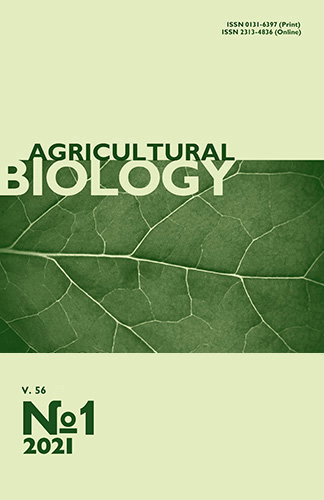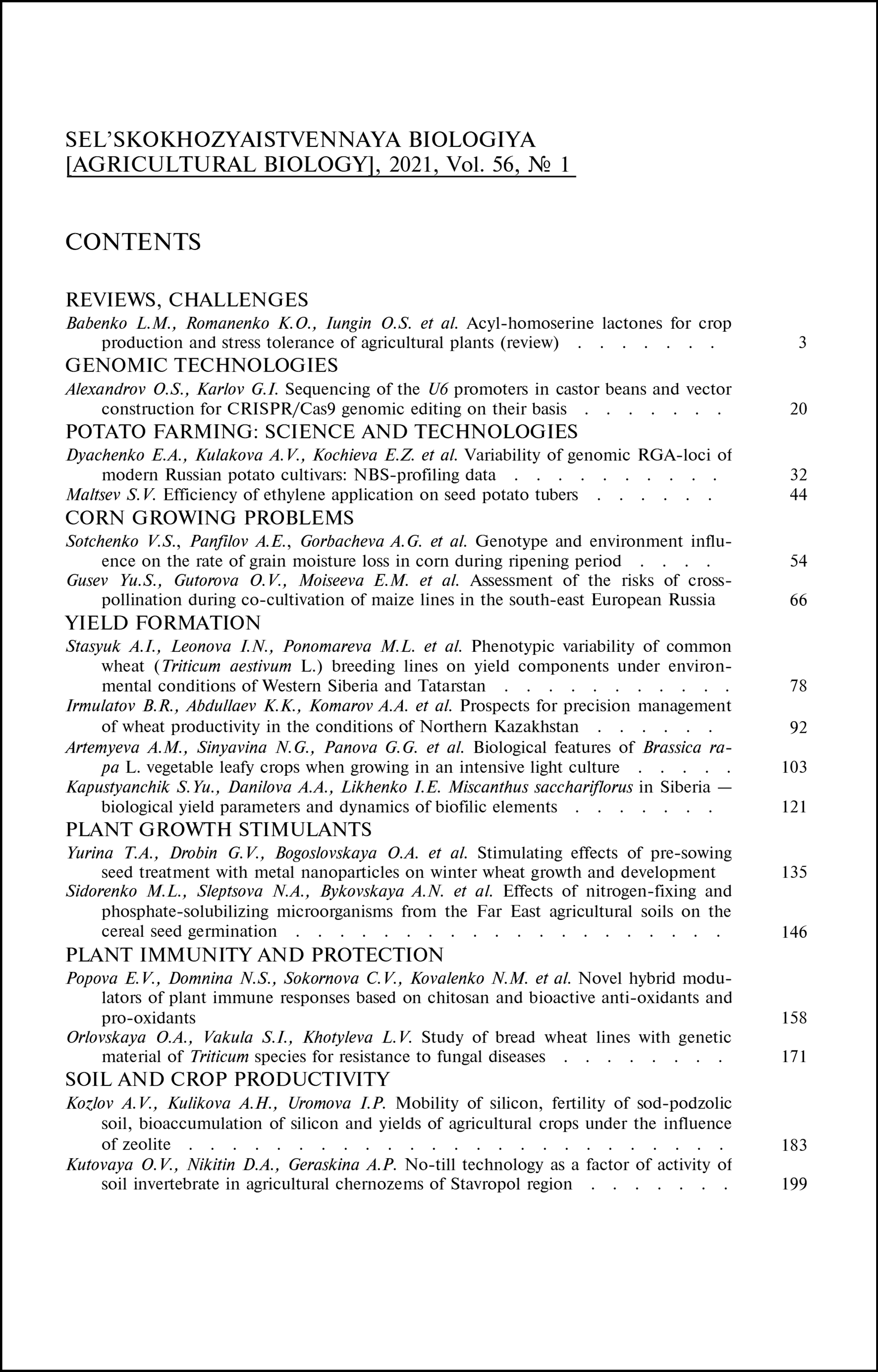doi: 10.15389/agrobiology.2021.1.92eng
UDC: 633.11:631.559.2:528.88
Acknowledgements:
The authors are deeply grateful to Academician Viktor P. Yakushev for insightful comments and suggestions in writing the article.
The work was performed within the framework of the program of the Baraev Scientific-production Center for Grain Farming LLP “Transfer and adaptation of technologies for precision crop production based on the ‘Demonstration farms (polygons)’ principle in the Akmola region”.
PROSPECTS FOR PRECISION MANAGEMENT OF WHEAT PRODUCTIVITY IN THE CONDITIONS OF NORTHERN KAZAKHSTAN
B.R. Irmulatov1, K.K. Abdullaev1, A.A. Komarov2 ✉, V.V. Yakushev2
1Baraev Scientific-production Сenter for Grain Farming, p. Shortandy-1, Shortandinsky District, Akmola Region, 021601 Kazakhstan, e-mail irmulatov61@mail.ru, tsenter-zerna@mail.ru;
2Agrophysical Research Institute, 14, Grazhdanskii prosp., St. Petersburg, 195220 Russia, e-mail: zelenydar@mail.ru (✉ corresponding author), mail@agrophys.com
ORCID:
Irmulatov B.R. orcid.org/0000-0002-8155-7817
Komarov A.A. orcid.org/0000-0003-1430-0509
Abdullaev K.K. orcid.org/0000-0001-7760-4636
Yakushev V.V. orcid.org/0000-0001-8434-5580
Received October 18, 2020
More complete realization of the wheat genetic potential will ensure increasing its yield and quality in the conditions of the Republic of Kazakhstan. Innovative agrotechnological approaches, including a precision farming system (PFS) allow the problem to be addressed. Given the large area of Kazakhstan, the incorporation of precision farming systems needs assessment of the state of its vast territories using the Earth remote sensing (ERS) technology. In this paper, for the first time in the conditions of Northern Kazakhstan, the methods of precision management of spring wheat productivity were implemented. The aim of the work was to assess the prospects for precision farming in the conditions of Northern Kazakhstan and to develop an algorithm not only for passive monitoring of the state of crops, but also for active management of the spring wheat yield using ERS. The field trials were performed on dark chestnut soils in the seasons of 2019-2020 (a special precision farming landfill, Baraev Production Center of Grain Farming) with highly productive spring wheat (Triticum vulgare L.) varieties of local selection, the Shortandinskaya 95 and Astana. At the first stage, the main agrochemical indicators of the test sites were characterized using a ground-based mobile complex. Soil fertility parameters were assessed using survey grids with 1, 5, and 25 ha plot grids. The data were used to identify intra-field heterogeneity and calculate fertilizer doses for differentiated application. The second stage involved crop assessment using images from the Sentinel-2 group satellites and photographs form unmanned aerial vehicles (UAV). Plant development during ontogenesis was characterized by normalized difference vegetation index (NDVI), and the yields were finally evaluated using electronic yield maps. At the third stage, the data were processed using the Stat and Microsoft Excel 2010 software package and AGROS-1 software (version 2.09-2.11/1993-2009). The main fertilizers were used at sowing and surface applied. Non-root feeding was also performed. Polymer fertilizers Vitanoll-NP (1 l/ha) and Vitanoll-micro (1 l/ha) (Agromarket-24 LLC, Russia), a complex chelated fertilizer CHF (2 l/ha) (Agrophysical Research Institute, Russia), and a humic fertilizer Stimullife (0.3 l/ha) (Agrofizprodukt LLC, Russia) were used. It was found that only one agrochemical inhomogeneity of the field was partially leveled by the PFS-based differentiated introduction of fertilizers. Soil fertility, landscape profile and hydrological parameters (soil moisture availability) are shown to dominantly affect the spring wheat yield in the arid conditions of Kazakhstan. The changes in the agricultural landscape conditions due to the slope of the terrain, allows us to trace watercourses that characterize the productive moisture availability in a particular part of the field. On the basis of remote sensing data and coupled ground measurements used to precisely assess and record soil, landscape and soil moisture conditions, an algorithm has been developed to manage the yield formation process in plants. It is shown that the more precise the data analysis, the higher the effect of crop yield management. An increase in yield was approximately 10 % for a 5-ha plot grid and 2 times more for a 1-ha plot grid. The correlation revealed between the wheat yield and NDVI is strong and uneven as depends on the spatial direction, that is, the r values are 0.64-0.99 along the slope transect and 0.62-0.98 broadwise the field. A significant increase in yield was obtained both due to the differentiated application of mineral fertilizers, by 9.5 % for the 5-ha grid and by 19.2 % the 1-ha grid, and due to timely non-root fertilizing, by 15-22.3 %. In general, our findings indicate the PFS prospects in the management of spring wheat productivity under the conditions of Northern Kazakhstan.
Keywords: spring wheat, Northern Kazakhstan, precision agriculture, remote sensing data, agro landscape, soil fertility, soil moisture.
REFERENCES
- Merchuk-Ovnat L., Fahima T., Ephrath J.E., Krugman T., Saranga Y. Ancestral QTL alleles from wild emmer wheat enhance root development under drought in modern wheat. Front. Plant Sci., 2017, 8: 703-715 CrossRef
- Araus J.L., Slafer G.A., Royo C., Serret M.D. Breeding for yield potential and stress adaptation in cereals. Critical Reviews in Plant Sciences, 2008, 27(6): 377-412 CrossRef
- Guo Y., Du Z., Chen J., Zhang Z. QTL mapping of wheat plant architectural characteristics and their genetic relationship with seven QTLs conferring resistance to sheath blight. PLoS ONE, 2017, 12(4): e0174939 CrossRef
- Uskov I.B., Yakushev V.P., Chesnokov Yu.V. Actual physical, agronomic, genetical and breeding aspects in agrobiological management (towards 85 anniversary of Agrophysical Research Institute, Russia). Sel'skokhozyaistvennaya biologiya [Agricultural Biology], 2017, 52(3): 429-436 CrossRef
- Panayi E., Peters G.W., Kyriakides G. Statistical modelling for precision agriculture: a case study in optimal environmental schedules for Agaricus Bisporus production via variable domain functional regression. PLoS ONE, 2017, 12(9): e0181921 CrossRef
- Banu S. Precision agriculture: tomorrow’s technology for today’s farmer. J. Food Process Technol., 2015, 6(8): 1000468 CrossRef
- Busse M., Doernberg A., Siebert R., Kuntosch A., Schwerdtner W., König B., Bokelmann W. Innovation mechanisms in German precision farming. Precision Agric., 2014, 15(4): 403-426 (doi: 10.1007/s11119-013-9337-2">CrossRef
- Spivak L.F., Terekhov A.G., Vitkovskaya I.S., Batyrbaeva M.ZH. Sovremennye problemy distantsionnogo zondirovaniya Zemli iz kosmosa, 2009, 6(2): 450-458 (in Russ.).
- Gopp N.V., Savenkov O.A., Smirnov A.V. Sovremennye problemy distantsionnogo zondirovaniya Zemli iz kosmosa, 2019, 16(3): 125-139 CrossRef (in Russ.).
- Roy D.P., Wulder M.A., Loveland T.R., Woodcock C.E., Allen R.G., Anderson M.C., Helder D., Irons J.R., Johnson D.M., Kennedy R., Scambos T.A., Schaaf C.B., Schott J.R., Sheng Y., Vermote E.F., Belward A.S., Bindschadler R., Cohen W.B., Gao F., Hipple J.D., Hostert P., Huntington J., Justice C.O., Kilic A., Kovalskyy V., Lee Z.P., Lymburner L., Masek J.G. McCorkel J. Shuai Y., Trezza R., Vogelmann J., Wynne R.H., Zhu Z. Landsat8: Science and product vision for terrestrial global change research. Remote Sensing of Environment, 2014, 145: 154-172 CrossRef
- Bastiaanssen W.G.M., Noordman E.J.M., Pelgrum H., Davids G., Thoreson B.P., Allen R.G. SEBAL model with remotely sensed data to improve water resources management under actual field conditions. Journal of Irrigation and Drainage Engineering, 2005, 131(1): 85-93 CrossRef
- Menges R.M., Nixon P.R., Richardson A.J. Light reflectance and remote sensing of weeds in agro-nomic and horticultural crops. Weed Science, 1985, 33(4): 569-581 CrossRef
- Thorp K., Tian L.F. A review on remote sensing of weeds in agriculture. Precision Agriculture, 2004, 5(5): 477-508 CrossRef
- Diker K., Heermann D. F., Bordahl M. K. Frequency analysis of yield for delineating yield response zones. Precision Agriculture, 2004, 5: 435-444 CrossRef
- Komarov A.A., Muntyan A.N., Sukhanov P.A. Izvestiya SPbGAU, 2018, 3(52): 64-70 (in Russ.).
- Tahar K.N. Multi rotor UAV at different altitudes for slope mapping studies. International Archives of Photogrammetry Remote Sensing and Spatial Information Sciences, 2015, XL-1/W4: 9-16 CrossRef
- Dospekhov B.A. Metodika polevogo opyta. M., 1985.
- Aggarwal C., Reddy C. Data clustering: algorithms and applications. CRC Press, Boca Raton, London, New York, 2013: 652.
- Ghassempour S., Girosi F., Maeder A. Clustering multivariate time series using hidden Markov models. International Journal of Environmental Research and Public Health. 2014, 11(3): 2741-2763 CrossRef
- Kelley D.R., Salzberg S.L. Clustering metagenomic sequences with interpolated Markov models. BMC Bioinformatics 2010, 2(11): 544 CrossRef
- Kataev M.Yu., Bekerov A.A., Shalda P.V. Doklady Tomskogo GUSUR,2017, 20(1): 81-84 CrossRef (in Russ.).
- Bradley B.A. A curve fitting procedure to derive inter- annual phenologies from time series of noisy satellite NDVI data. Remote Sensing of Environment, 2007, 106(2): 137-145 CrossRef
- Hird J.N. Noise reduction of NDVI time series: An empirical comparison of selected techniques. Remote Sensing of Environment, 2009, 113: 248-258 CrossRef
- Jönsson P., Eklundh L. TIMESAT – A program for analyzing time-series of satellite sensor data. Computers & Geosciences, 2004, 30(8): 833-845 CrossRef
- Komarov A.A., Komarov A.A. Agrokhimicheskii vestnik, 2018, 6: 34-38 CrossRef (in Russ.).
- Kurtener D.A., Komarov A.A., Krueger E.D., Lavrukov M.Yu, Nayda N.M. Fuzzy multi-attributive analyzes of organic-mineral fertilizer “Stimulayf” and “Humate Sodium” application for cultivation of Dracocephalum L. European Agrophysical Journal, 2014, 1(1): 14-24 CrossRef
- Bekmukhamedov N.E., Ayupov K.A., Karabkina N.N., Degtyareva O.V., Vorotyntseva V.V. Materialy chetyrnadtsatoi Vserossiiskoi konferentsii «Sovremennye problemy distantsionnogo zondirovaniya Zemli iz kosmosa» [Proc. 14th Russian Conf. «Current problems of the Earth remote sensing from space»]. Moscow, 2016: 328 (in Russ.).
- Terekhov A.G. Sovremennye problemy distantsionnogo zondirovaniya Zemli iz kosmosa, 2008, 5(2): 371-375 (in Russ.).
- Terekhov A.G. Sovremennye problemy distantsionnogo zondirovaniya Zemli iz kosmosa, 2010, 7(3): 305-314 (in Russ.).
- Abdullaev K., Irmulatov B., Komarov A., Nugis E. Precision agriculture in the North of Kazakhstan. Journal of Agricultural Science,2020, 31(2): 115-121 CrossRef
- Wang L., Liu H. An efficient method for identifying and filling surface depressions in digital elevation models for hydrologic analysis and modelling. International Journal of Geographical Information Science, 2006, 20(2): 193-213 CrossRef
- Hengl T., Evans I.S. Mathematical and digital models of the land surface. Developments in Soil Science, 2009, 33: 31-63 CrossRef
- Lushnikova T.A. Vestnik KGU, 2012, 3: 70-76 (in Russ.).












